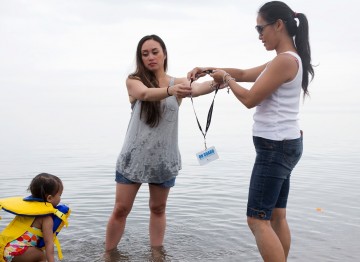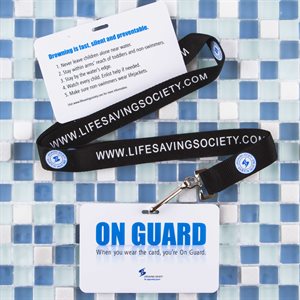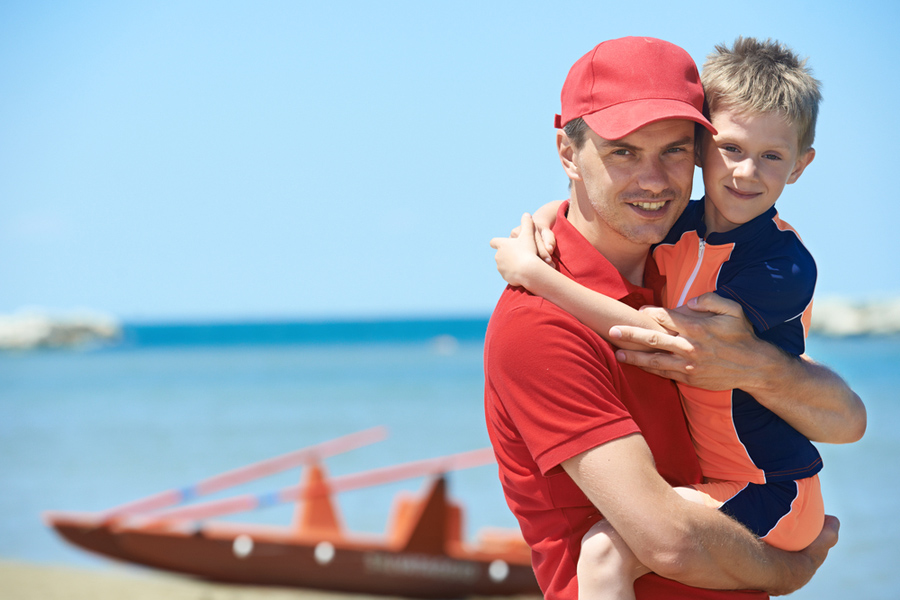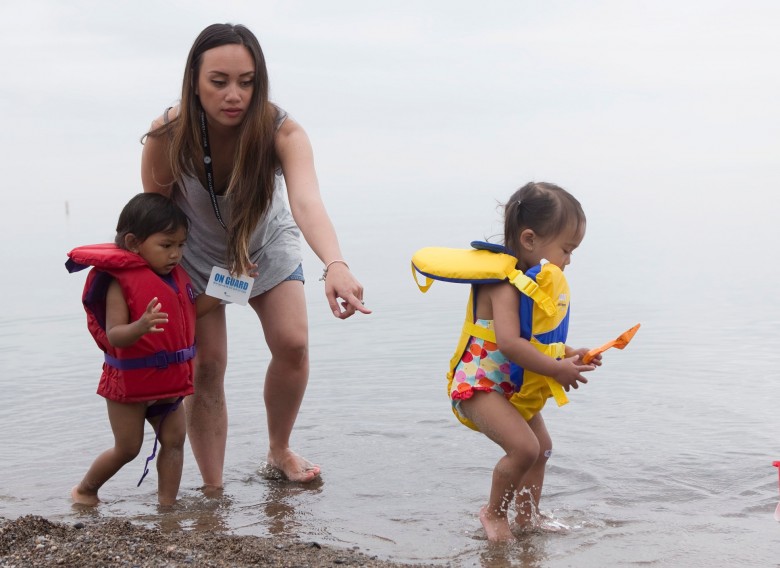About a week ago a friend of mine had posted a question on her Facebook page. She was asking something about at what age is it okay to allow your kid to swim without supervision. My gut response was “if you have to ask then that should be your answer.” Most of her friends reacted strongly to keeping an eye on the kids.
It’s summer time and the pools are open. The Lifesaving Society and Toronto Lifeguards want to remind us of the importance of safety around the waters. I had a chance to ask Barbara Byers, Public Education Director, Lifesaving Society, about water safety and the new ON GUARD tool to help reduce accidents and drowning deaths especially for kids under the age of 10.
What are the top misconceptions that parents have when it comes to lifesaving skills around the water?
Some of the most common misconceptions parents have about lifesaving skills around water are:
- Overestimating the abilities of their children — thinking that since they have had lessons they can be left alone
- Thinking that a drowning child will be easy to spot — splashing around or calling out for help
- Thinking they can step away for “just a minute”
- When there are multiple adults, assuming that someone else is watching
Often at a family outing or a backyard pool party, there are multiple adults watching the children near water, and so it’s easy to assume that someone else is supervising while you turn your attention away momentarily. Drowning can happen quickly and quietly and go unnoticed, even when people are nearby. It’s important to identify someone who is specifically responsible for supervising. A tool like the ON GUARD card helps to remove any doubt about who is “on duty”.
Children can be impulsive and unpredictable, especially young children.
Many people think that the signs of drowning are splashing and yelling by the victim (we often see that in the movies), so, can you explain what happens really?
Most people believe that they will be able to recognize a drowning child because they will cry for help or splash and wave their arms. In fact, a child in distress is more likely to slip quietly under the water, unable to call or reach out for help because they can’t keep their arms or heads above water. Drowning can happen quickly and quietly and go unnoticed even when people are nearby. That’s why parents and caregivers need to be especially vigilant when supervising young children. Watching the child’s face and maintaining eye contact is very important.
What about life jackets, flotation devices and water wings? What should we be looking for?
The Lifesaving Society recommends that all young children and non-swimmers wear life jackets or PFDs when they are in or near water. A range of products, including things like water wings and padded bathing suits, are available, but these are really just toys and often have a warning stating that they are not personal flotation devices. Parents should look for a life jacket or PFD that has a label indicating it is approved by Transport Canada.
I often hear parents say “oh my child is a strong swimmer,” how do you respond to that?
Children can be impulsive and unpredictable, especially young children. While they can often recite water safety rules, they don’t always know when and how to apply them. It’s important that parents and caregivers supervise all children when they are in and near water.
 What are a few steps that parents can do to keep us (and our kids) safe near the waters?
What are a few steps that parents can do to keep us (and our kids) safe near the waters?
The Lifesaving Society has developed a tool called the ON GUARD card to help remove any doubt about who is specifically responsible for watching the children and to ensure that parents and caregivers are especially vigilant while supervising young children and non-swimmers in or around water.
The plastic card is worn on a lanyard around the neck and those who wear it are responsible for committing 100% of their attention to their role as supervisor and for finding another adult to relieve them if they need to turn their attention away for any reason – checking email, flipping burgers or attending to another child.
The back of the card provides the following tips for parents and caregivers to help ensure that they are supervising effectively:
- Never leave children alone near water.
- Stay within arms’ reach of toddlers and non-swimmers.
- Stay by the water’s edge.
- Watch every child. Enlist help if needed.
- Make sure non-swimmers wear life jackets.
 Individuals or organizations can purchase the ON GUARD water safety card online at www.lifesavingsociety.com or by calling the Lifesaving Society directly at 416-490-8844. The card costs $7.50 each or $125 for 25 cards.
Individuals or organizations can purchase the ON GUARD water safety card online at www.lifesavingsociety.com or by calling the Lifesaving Society directly at 416-490-8844. The card costs $7.50 each or $125 for 25 cards.
SUMMER WATER SAFETY TIPS FOR PARENTS AND CAREGIVERS OF YOUNG CHILDREN
Provided by the Lifesaving Society
Spending time in and around water is lots of fun, especially for young children. However, drowning is the second leading cause of preventable death for children under 10 years of age, and children under 5 are most at risk.
The backyard pool is the most common place where children under 5 drown, but drowning can occur in as little as 10 seconds and can occur in just inches of water. Parents and caregivers need to be vigilant around all types of water – pools, beaches, even splash pads.
- Never leave children alone near water. And stay close – within arms’ reach.
- Use a system like the ON GUARD card to designate a specific adult to be responsible for supervising children in or around water. Watch every child and enlist help if needed.
- Make sure to give 100% of your attention when supervising. Put cell phones, magazines and BBQ duties aside. Find another adult to take over if you need to turn away for any reason.
- Watch the face – especially the eyes. Many victims don’t call, wave or signal for help because they can’t keep their head or arms above water.
- Stay by the water’s edge and make sure you have a clear view of the whole area – be ready to respond quickly.
- At the pool, the lake or the beach, young children and children who can’t swim should wear a life jacket or personal flotation device (PFD).
- Restrict access to backyard pools by fencing all sides.
- Never rely on a single measure to prevent young children from getting into a pool. Use multiple barriers or strategies to restrict access.
- Empty and turn over wading pools and buckets of water when not in use.
- Keep hot tubs covered when not in use.
- Take parent & tot lessons at your local pool. A positive introduction to water is important and gives toddlers a chance to get used to water with their parents in an instructional setting.


My 13 year old has been a strong swimmer and is taking her Bronze Medallion Course next week – I still do not let her swim without supervision. Have you ever had a cramp in the water- almost impossible to get to the edge of the pool or to the shoreline. And I ensure she’s around when I go into the lake.
yup…”i can swim” does no good when you slip, fall and hit your head. good column…